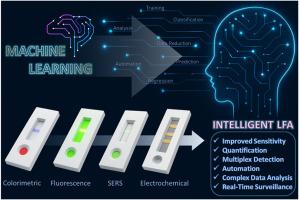Machine learning-integrated lateral flow assays: Unlocking the future of intelligent point-of-care sensing
IF 12
1区 化学
Q1 CHEMISTRY, ANALYTICAL
引用次数: 0
Abstract
Lateral flow assays (LFAs) have evolved from simple, rapid tests into sophisticated platforms capable of high-sensitivity biomarker detection. Advanced formats such as nanozyme-based, fluorescence, surface-enhanced Raman scattering (SERS), and electrochemical LFAs now offer unprecedented analytical capabilities but also produce complex signal outputs that challenge traditional interpretation methods. This raises a critical question on which computational strategies can unlock their full potential. Machine learning (ML) and deep learning (DL) provide powerful solutions, enabling automated, quantitative, and intelligent analysis. In this review, we critically assess the suitability of different ML algorithms for each LFA format, highlighting their strengths, limitations, and implementation considerations. Unlike broader reviews on point-of-care diagnostics, our work focuses exclusively on LFAs, illustrating how ML can enhance sensitivity, minimise user dependency, enable multiplexing, and support real-world deployment. By addressing challenges of data variability, standardization gaps as well as integration into regulatory and healthcare frameworks, we outline the role of ML in shaping robust, next-generation intelligent LFA platforms.

机器学习集成横向流量分析:解锁智能护理点传感的未来
横向流动分析(LFAs)已经从简单、快速的测试发展成为能够高灵敏度生物标志物检测的复杂平台。先进的格式,如纳米酶,荧光,表面增强拉曼散射(SERS)和电化学LFAs现在提供前所未有的分析能力,但也产生复杂的信号输出,挑战传统的解释方法。这就提出了一个关键问题,即计算策略可以释放它们的全部潜力。机器学习(ML)和深度学习(DL)提供了强大的解决方案,实现了自动化、定量和智能分析。在这篇综述中,我们批判性地评估了每种LFA格式的不同ML算法的适用性,强调了它们的优势、局限性和实现考虑因素。与对即时诊断的广泛评论不同,我们的工作专注于lfa,说明ML如何提高灵敏度,最大限度地减少用户依赖,实现多路复用,并支持实际部署。通过解决数据可变性、标准化差距以及集成到监管和医疗保健框架中的挑战,我们概述了ML在塑造强大的下一代智能LFA平台中的作用。
本文章由计算机程序翻译,如有差异,请以英文原文为准。
求助全文
约1分钟内获得全文
求助全文
来源期刊

Trends in Analytical Chemistry
化学-分析化学
CiteScore
20.00
自引率
4.60%
发文量
257
审稿时长
3.4 months
期刊介绍:
TrAC publishes succinct and critical overviews of recent advancements in analytical chemistry, designed to assist analytical chemists and other users of analytical techniques. These reviews offer excellent, up-to-date, and timely coverage of various topics within analytical chemistry. Encompassing areas such as analytical instrumentation, biomedical analysis, biomolecular analysis, biosensors, chemical analysis, chemometrics, clinical chemistry, drug discovery, environmental analysis and monitoring, food analysis, forensic science, laboratory automation, materials science, metabolomics, pesticide-residue analysis, pharmaceutical analysis, proteomics, surface science, and water analysis and monitoring, these critical reviews provide comprehensive insights for practitioners in the field.
 求助内容:
求助内容: 应助结果提醒方式:
应助结果提醒方式:


